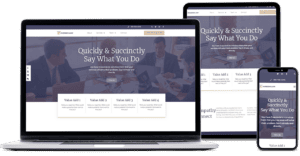How to Strategize Your Website’s Content
- You’ve got a business. Check.
- You’ve got a domain name. Check.
- You’re ready to start designing your website, so you hire a website designer. Check. One of the first questions the designer asks is if you have your website content completed. Oops!
Wait, what do you mean by “content”? Content is put simply, the text and visuals you will have on your site. Some examples of different types of content are articles, case studies, pictures and videos, infographics and blog posts.
Why does your web designer want your content first?
Your developer needs your content first so she can:
- understand the message for each page
- know how much content will be on the page for layout and design
- identify the location for calls-to-action
- create a sitemap to establish whole site architecture
Your web design team can create a much better website if they know how much content each page will contain. Knowing which pages are going to have only a few sentences or a few paragraphs is crucial to the design phase.
In the business world, your website is a vital marketing tool in attracting, educating and retaining customers, and every website needs content. Let’s go over some concepts and strategy to help you get started.
It’s not about you!
The first thing to understand is that your website is not about you. It’s about the user…what they need and are interested in. So, when you’re planning the text for your web pages, this is very important to remember.
Tip: Create a user story to help direct the content to the person looking at your website.
Your website’s homepage is generally the first page customers see. It is your welcome mat. Users general take only about 5 seconds to size you up and decide if your site is relevant for them.
Questions to ask about the top portion of your website
- Is it immediately clear to the user what you do?
- Are you using industry jargon or terms your user would use in a search?
- Avoid using imagery your user may not understand. The home page needs to have a clear and direct message that the user can instantly identify with.
- What problem does the user have that lead them to your website?
- Is there an easy call-to-action that leads them to their solution?
- Is it clear you are the solution to their problem?
- Is there a simple path to contact you?
Your website should be engaging and should invite visitors to dig deeper and explore your business. While the homepage is important, so are all the other support pages. The role of your website and its content should be to drive sales and leads to maximize your return on investment.
When you create your website content, the goal should be to create user-friendly, engaging material for your readers. Customers will notice bad content. Content writing should not be a low priority or a last-minute item in the creation of your website. One way to avoid having last minute, low-quality content is to start thinking about your content before the layout and aesthetics. Here are some suggestions for your content strategy so you can get to writing content your customers want to read.
Getting started
The first steps in your content creation strategy should be planning, assigning roles and creating realistic timelines. Decide who is responsible for brainstorming content, who is responsible for creating the content, and who will need to review the content for final approval. Discuss how and when it will be shared with your web design team. Keep in mind that any delays in content creation can delay your web design and, ultimately, your website launch.
Understand your audience
Before you begin the brainstorming and writing, it’s important to first understand your audience. Some businesses start by creating personas and user stories for their audience and customers. These user stories help illuminate problem(s) that each individual customer might have and how your product or service can help. Try to communicate your unique selling proposition to each of your user and potential customer.
This is how you drive your ideal customer to your website!
Create your unique selling proposition with a user story.
Consider the pages and formats
What pages do you expect to have on your new website? Decide what page style or format matches the content that you are creating. It can help to make a list of the pages you plan to include in your website, such as the homepage, service/product information, case studies and/or testimonials, a product gallery, videos, an about us page, FAQs, a blog and contact information. Not all companies will have all of these pages (and some will have more). Once you decide what page types and formats your website requires, you can get started creating the actual content that will live on each page.
Other considerations
Before you create any content, decide on the overall tone for your website. Is the content going to playful and friendly, straightforward and businesslike, or somewhere in between? Your tone may be dictated by your products or services as well as your audience.
You may also want to create a hierarchy for your content. Decide which content is most important and absolutely needs to be in place before launching your website. From there, you can determine if other content can be created and added post-launch. For example, many businesses get the core of their website completed before writing and posting to a blog.
Brainstorming
For each page of content you create, you may want to brainstorm ideas before writing.
Here are some helpful pre-writing questions to ask for each page on our website:
– Have you established your brand message?
– Who is this page for?
– What is the purpose of this page?
– What questions do we need to answer for our audience?
– What do we want the user to do?
For additional help with content ideas, there are some great tools available online. Many are particularly good if you’re trying to create content for your blog. These tools include BlogAbout, HubSpot’s Blog Ideas Generator, and BuzzSumo. This Forbes article even has some great content ideas to get your ideas flowing.
What about SEO?
Of course, you’ll want to rank well for terms that match your business/industry/products, but there’s no need to fit all of these keywords on one page of your website. A best practice is to target only a few keywords per page, with your most important and most difficult terms on the homepage. You don’t want to sacrifice the message of your content for SEO purposes. It’s better to add in your keywords naturally. Focus on your audience and the SEO should come naturally.
The content is done. Now what?
Remember that great website content is a process. It’s not usually a “create content for a website launch and never update it” thing. Continually add to your website with your new products and services. Keep an eye on your website analytics to find popular pages and keywords. Update and expand on those pages and terms to keep your customers engaged. Make your website fresh by adding new content that is relevant to current issues in your industry. Consider blogging and case studies for fresh content and a boost to your SEO.
Your website is the most valuable marketing tool you have! It is worth the time and investment to get it right. Quality content creation takes time and effort, but it’s so worth it? Your customers and your business will be happier if you plan and create a website content strategy.





